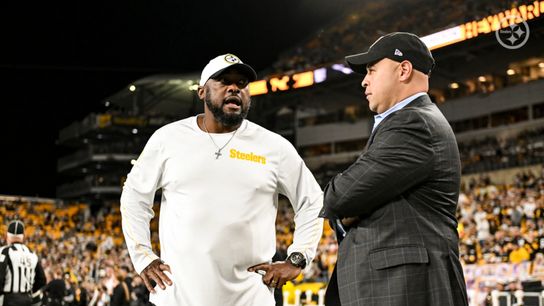As the Pittsburgh Steelers prepare for their 2025 campaign, the early-season matchups are already generating discussion among bettors. The first four scheduled games offer an interesting case study in line movement and how and why odds shift between schedule release and kickoff.

Karl Roser / Pittsburgh Steelers
Mike Tomlin and Omar Khan speaking on the sidelines inside Acrisure Stadium
From international travel to quarterback changes, a range of factors can subtly or dramatically impact how sportsbooks set and adjust the lines. Understanding these movements helps bettors and fans alike make sense of what the market expects and how external variables shape that narrative.
What Impacts Early Line Movement in NFL Matchups
Bettors often overemphasize star power or headlines, but the some of the most influential triggers for line movement tend to come from structural shifts in readiness, depth, and location. The Steelers' first month delivers all of these in some form, with three road games and one international fixture.
Roster Developments and Their Immediate Effect
The Steelers’ offseason has featured a few high-profile changes. The trade for DK Metcalf from Seattle reshaped Pittsburgh’s receiving corps. While such acquisitions don’t always move lines on announcement alone, they influence sentiment and impact once depth charts clarify during camp.
Equally significant is the confirmed addition of Aaron Rodgers at quarterback. His arrival has shifted both fan expectations and bookmaker projections. Veteran quarterbacks with Rodgers' pedigree tend to move lines more than most position players, especially when Rodgers-focused news dominates the latest NFL news cycle.
While Donald Parham Jr.'s season-ending Achilles injury slightly reduced red-zone depth, it’s the quarterback and receiver duo now in place that’s drawing market attention. Oddsmakers will continue refining numbers as preseason reps reveal chemistry, timing, and system adjustments.
Travel, Timing, and Neutral Fields
Three of Pittsburgh's first four games are outside of Pennsylvania. Week 4, in particular, sees the team travel to Dublin to face the Vikings. This is the NFL's first-ever regular season game in Ireland, and it's considered a neutral-site matchup.
Neutral fields tend to compress point spreads. Bettors have seen this in London games: teams lose the usual home-field advantage. That factor has started nudging Pittsburgh’s implied margin closer to even in early look-ahead lines.

Sang Tan / ap photo
Steelers' LeVeon Bell (#26) scores his first NFL touchdown in London, England in 2013 against the Vikings.
How the Steelers' First Four Games Reflect Broader Betting Behavior
Each of the Steelers' early matchups brings a unique dynamic - and line activity tells part of that story. Understanding the context around those shifts reveals patterns that apply across the league.
Week 1 at the New York Jets: Familiar Faces, Unpredictable Lines
When the Steelers visit MetLife Stadium, they could face Justin Fields, the former Pittsburgh quarterback now with the Jets under center. Narrative value matters. Books know media attention on revenge games can increase handle, and they price accordingly.
This game also reflects betting activity's response to quarterback clarity. If either team names a starter with a contrasting style (e.g., a mobile QB vs. a pocket passer), totals and spreads may both shift. These swings often come early in the week once media reports gain traction.
Week 2 vs Seattle: Home Opener Meets Familiar Personnel
The Steelers' first game at Acrisure Stadium brings intrigue. Metcalf faces his former team, and the Seahawks' secondary remains a question mark. Still, early totals have stayed cautious.
What stands out in early line behavior is the impact of home openers. Public bettors often lean toward emotional narratives. Historically, home openers drive more early-week action than neutral games, which can temporarily inflate lines before sharp bettors push them back.
Another key factor is travel imbalance. Seattle traveling east for a 1:00 PM EDT start often results in slow first halves, a trend reflected in halftime totals more than full-game lines. Oddsmakers adjust slowly in these situations, letting early sharp money guide total movement.
Week 3 at New England: Defensive Reputation vs Offensive Identity
The New England Patriots have long been seen as a defense-first team, and this reputation lingers in the betting space. Early spreads and totals for this matchup reflect modest expectations on both sides.
When betting markets expect this type of matchup, totals typically move in response to injury news more than anything else. A key offensive lineman being ruled out could lower the total by a full point. It’s that sensitive.
Week 4 vs Minnesota in Dublin: Global Spotlight, Narrow Edges
Playing abroad adds layers of complexity. Altitude, surface type, time zones, and crowd bias all factor in, and oddsmakers incorporate them subtly.
Player availability also has amplified importance overseas. Travel limitations reduce roster flexibility, so any late injuries to starters often create stronger-than-usual moves. Books brace for this with smaller max bet limits early in the week.
How To Interpret These Movements
Line movement isn’t just noise, it’s information. Observing how and when lines shift can reveal sentiment, vulnerability, and even signal where sharp action is concentrated. This is especially relevant in the first month when uncertainty is part and parcel of the action.
Reading the Why Behind the Moves
Not all movement stems from injury or news. Sometimes it’s simply a volume shift. If the public leans heavily one way, lines may adjust to balance exposure. That doesn’t necessarily mean the betting market "knows" something.
Understanding this is especially important when comparing early-season trends across different franchises. The variables influencing movement—quarterback uncertainty, travel strain, or even fan perception, are consistent across the league.
Whether you're tracking the Steelers or betting on all NFL teams, knowing what typically drives line shifts can help you interpret what the market is reacting to and when it's just noise.
What Not To Assume From Shifting Lines
Line changes aren’t always predictions. A team moving from +3 to +2.5 isn’t suddenly favored. It often just reflects balancing the books. Chasing movement without understanding context can lead to poor assumptions.

Steelers.com
For fans following the Steelers, the best way to view these changes is as signals, not verdicts. Let the shifts inform where uncertainty exists, but always return to fundamentals: matchups, health, coaching, and preparation. The betting market may adjust fast, but smart analysis adjusts patiently.
This September Will Say a Lot
The Steelers’ first four games represent a compressed test across multiple fronts: travel, continuity, and market perception. Line movement throughout this stretch won’t just reflect the scoreboard, it will also hint at how bettors and bookmakers interpret the team’s direction.
Watching the lines closely is less about chasing trends and more about learning how information, momentum, and margins evolve. For Pittsburgh, every early shift will tell a story. The key is knowing how to read it.


